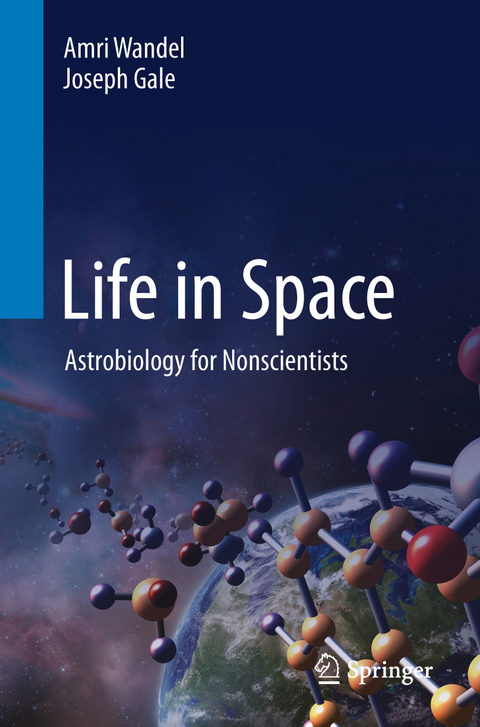
Life in Space
Springer International Publishing (Verlag)
978-3-031-64638-6 (ISBN)
- Noch nicht erschienen - erscheint am 06.02.2025
- Versandkostenfrei innerhalb Deutschlands
- Auch auf Rechnung
- Verfügbarkeit in der Filiale vor Ort prüfen
- Artikel merken
Over the last two decades alone, new technology and space missions have profoundly changed our understanding of prospective extraterrestrial life in the universe. The resulting field of astrobiology has become a highly eclectic and interdisciplinary pursuit, encompassing many of the natural sciences and holding ramifications for nearly all other areas of study. Co-written by an astrophysicist and a biologist, this introductory undergraduate textbook presents an overview of astrobiology for students from all backgrounds. Addressed in its chapters are the recent detection of potentially habitable planets and the prospects for detecting biosignatures and life; the celestial and geological factors that enabled the appearance and evolution of life on Earth; and other factors that continue to affect life up to the present, such as climate change. Based on over twenty years of university coursework, and in particular the authors' own interdisciplinary astrobiology curriculum, the text is accessible not just for the budding science major, but for any undergraduate student or lay reader excited by the prospect of life in the universe.
Dr. Amri Wandel has created and is teaching the course "Astrophysics and Life in the Universe", with over hundred students annually, to science and non-science undergraduate programs at the Hebrew University of Jerusalem, and a few times at the Astronomy program at UCLA. He frequently gives public talks and media interviews on astrobiology. His main research has been on active galaxies and massive black holes, and in the last years works also in astrobiology, in particular on habitability of exoplanets. Wandel has published over 100 scientific papers, over 40 in refereed journals (mainly ApJ). He coauthored the book "The Cosmos and Us" (in Esperanto, FEL 2001,2005, 2017). He is Chairman of the Israel society for Astrobiology and the Origin of Life (ILASOL), and member of the International Astronomical Union and its astrobiology commission F3.
Dr. Joseph Gale carried out research and served for some years as consultant to NASA's CELSS project(Controlled Environment Life Support Systems). From there he became interested in the exobiology program, later astrobiology. Gale has built and taught a program on "The Astrobiology of Planet Earth" an elective for third year science students, which over the last decade attracts some one hundred students each year. He has lectured at numerous national and international conferences. In last two years, he was invited to participate in astrobiology seminars of the University of Stockholm and the International Space University. Gale has published some 100+ papers and coauthored four books, including "Plants in Saline Environments" (Springer-Verlag 1975) and "Astrobiology of Earth" (OUP 2009).
1. What is Astrobiology?.- 2. Do we know what we are looking for? Can we define life? Why water?.- 3.The cosmic zoo: from our Solar System to distant galaxies.- 4. A short history of Astrobiology: from the Persians and Epicureans to discovering exoplanets and the Kepler space telescope.- 5. The tools of science: measurement, questions and hypotheses. Statistics, good and evil. How science differs from journal reports.-6. A few units necessary for Astrobiology.- 7. The Habitable Zone of our solar system and of other star systems.- 8. Our star - the Sun.- 9. Is Earth special? 10. The evolution of life on Earth, from prokaryotes to Homo sapiens, and its effects on Earth.- 11. The role of an atmosphere: climate and habitability.- 12. The potential for life on the terrestrial planets: Mercury, Venus and Mars.- 13. The potential for life on the outer planets: Jupiter, Saturn, and their moons: Europa, Enceladus and Titan.- 14. The small bodies in the Solar System: carbonaceous meteorites, asteroids and comets, and their possible impact on life.- 15. The quest for exoplanets: detecting planetary systems around other stars.- 16. Biosignatures.- 17.How different could alien life be?.- 18. Stellar types and their habitable zones.- 19. The structure of our galaxy, the Milky Way and other galaxies: is there a galactic habitable zone?.- 20. Cosmology and life: "long long ago, in a galaxy far far away" - from the Big Bang to the anthropic principle.- 21.The chances of finding extraterrestrial Complex and Intelligent life: SETI. The Drake equation and interstellar communication.- 22. Can we reach the stars? Space flight and advanced propulsion techniques.- 23. The Fermi paradox: where are all the aliens?.- Glossary.- Index.
| Erscheint lt. Verlag | 6.2.2025 |
|---|---|
| Zusatzinfo | X, 290 p. 200 illus. in color. |
| Verlagsort | Cham |
| Sprache | englisch |
| Maße | 155 x 235 mm |
| Themenwelt | Naturwissenschaften ► Physik / Astronomie ► Astronomie / Astrophysik |
| Schlagworte | astrobiology for non-science majors • astrobiology primer • biosignatures explained • drake equation explained • ethics in astrobiology • evolution of life in the universe • exoplanets • fermi paradox explained • introduction to astrobiology • nonmathematical astrobiology • prospects for extraterrestrial life • SETI • study of astrobiology • user-friendly astrobiology • what is a habitable zone • what is astrobiology • what is the cosmic zoo |
| ISBN-10 | 3-031-64638-X / 303164638X |
| ISBN-13 | 978-3-031-64638-6 / 9783031646386 |
| Zustand | Neuware |
| Haben Sie eine Frage zum Produkt? |
aus dem Bereich


